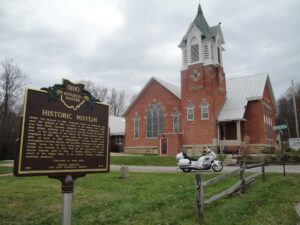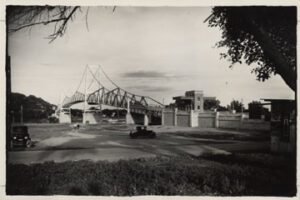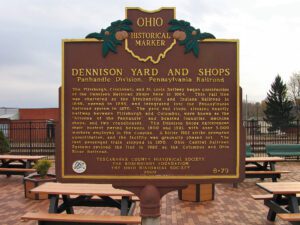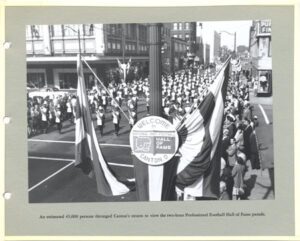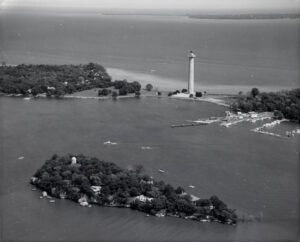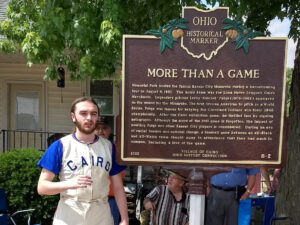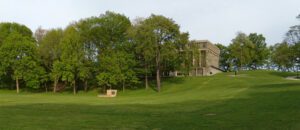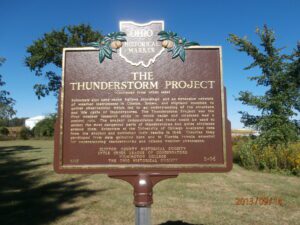, OH
Mifflin was founded in 1816. Originally known as Petersburg, the name was changed in 1827 in honor of the settlers that moved here from Mifflin Township, Allegheny County, Pennsylvania. The first village jailhouse and crossroad watering trough are located here, on the grounds of the historic St. Michael Lutheran Church. Organized in 1835, the church built this house of worship in 1890. As early as 1810, stagecoaches traveled Mifflin’s main thoroughfare between Wooster and Mansfield, stopping at the watering trough, known for “the best spring water in Ohio”. In 1925, the trough was removed to allow room for the construction of the Lincoln Highway built in 1928. A Lincoln Highway “L” marker stands in the village today, in its original location, directing motorists eastbound.
, OH
On December 15, 1967, about one mile downstream from this historic marker, a national tragedy occurred. Forty-six interstate travelers lost their lives when the Silver Bridge collapsed into the Ohio River during five o’clock rush hour traffic. The 2,235 foot two-way vehicular bridge connected Point Pleasant, West Virginia and Kanauga, Ohio via U.S. Route 35. The West Virginia Ohio River Company built the structure in 1928 for $1.2 million. The bridge, unique in its engineering conception, was the first of its design in America and the second in the world. Instead of woven-wire cable, the bridge was suspended on heat-treated eye-bar chains. It was named the “Silver Bridge” because it was the first in the world to be painted with aluminum paint. In 1969, two years later, its replacement, the Silver Memorial Bridge was dedicated.
, OH
The Pittsburgh, Cincinnati, and St. Louis Railway began construction of the Dennison Railroad Shops here in 1864. This rail line was chartered as the Steubenville and Indiana Railroad in 1849, opened in 1855, and integrated into the Pennsylvania Railroad system in 1870. The yard and shops, situated exactly halfway between Pittsburgh and Columbus, were known as the “Altoona of the Pan Handle” and boasted foundries, machine shops, and two roundhouses. The Dennison Shops experienced their busiest period between 1900 and 1921, with over 3,000 workers employed in the complex. A bitter 1922 strike prompted consolidation, and the facility was gradually phased out. The last passenger train stopped in 1970. Ohio Central Railroad Systems revived the line in 1992 as the Columbus and Ohio River Railroad.
, OH
On September 17, 1920, representatives from ten professional football teams met in Canton and formed the American Professional Football Association, which in 1922 became the National Football League (NFL). Pro football evolved from club football in the 1890s, and by the early 1900s had begun to spread across the country, concentrating in the Midwest. Jim Thorpe, the first nationally prominent pro, started with the Canton Bulldogs-an early pro football power-in 1915. In 1959, Canton citizens launched a well-organized and ultimately successful effort to have their city, “the cradle of professional football,” designated as the site of a monument to the sport’s historic stars. The Professional Football Hall of Fame opened on September 7, 1963, inducting seventeen charter members. The Hall of Fame interprets and promotes the study of the role of professional football in American culture.
, OH
This 6.5 acre island, named for the resemblance of its dolomite ledges to the Rock of Gibraltar, was the likely observation site for Commodore Oliver Hazard Perry’s naval forces during the Battle of Lake Erie in September 1813. Stone Laboratory, located on both Gibraltar and South Bass islands, is the oldest freshwater biological field station and research laboratory in the United States. Founded in 1895 as the Lake Laboratory, it was named for Franz Stone, whose son Julius purchased the island from the Jay Cooke family and presented it to Ohio State University in 1925. It continues as the research and teaching laboratory for the Ohio Sea Grant College Program. The Jay Cooke Castle on the island is a National Historic Landmark.
, OH
Memorial Park hosted the famous Kansas City Monarchs during a barnstorming tour on August 4, 1961. The home team was the Lima Metro League’s Cairo Merchants. Legendary pitcher Leroy “Satchel” Paige (1906-1982) appeared on the mound for the Monarchs. The first African American to pitch a World Series, Paige was famous for helping the Cleveland Indians win their 1948 championship. After the Cairo exhibition game, he thrilled fans by signing autographs. Although the score of the 1961 game is forgotten, the impact of meeting Paige and other Kansas City players is remembered. During an era of racial tension and national change, a baseball game between an all-Black and all-White team taught many in attendance that they had much in common, including a love of the game.
, OH
In 1968, Richard Nixon won the presidency partly based on a campaign promise to end the Vietnam War. Though the war seemed to be winding down, on April 30, 1970, Nixon announced the invasion of Cambodia, triggering protests across college campuses. On Friday, May 1, an anti-war rally was held on the Commons at Kent State University. Protestors called for another rally to be held on Monday, May 4. Disturbances in downtown Kent that night caused city officials to ask Governor James Rhodes to send the Ohio National Guard to maintain order. Troops put on alert Saturday afternoon were called to campus Saturday evening after an ROTC building was set on fire. Sunday morning in a press conference that was also broadcast to the troops on campus, Rhodes vowed to “eradicate the problem” of protests at Kent State. (Continued on other side)
, OH
Before and during World War II, the aviation industry was vulnerable to adverse weather conditions, particularly thunderstorms. In 1945, Congress mandated the nation’s first large-scale, scientific study of thunderstorms. The Thunderstorm Project was a cooperative undertaking of the U.S. Weather Bureau, Army Air Force, Navy, and the National Advisory Committee for Aeronautics (predecessor of NASA). The first phase of the project was conducted in Florida in 1946 and the second phase in Clinton County in 1947, partly because weather fronts frequently pass through this area. Pilots from the Clinton County Army Air Force Base made many flights through storms of varying intensities and all stages of development. (Continued on other side)


